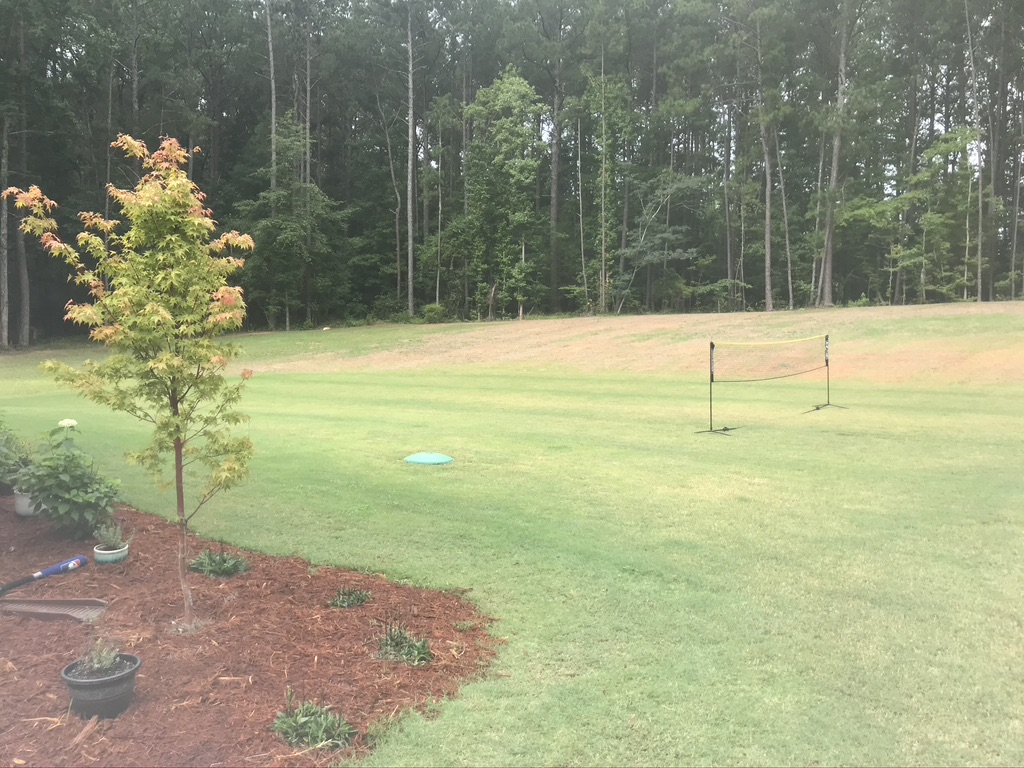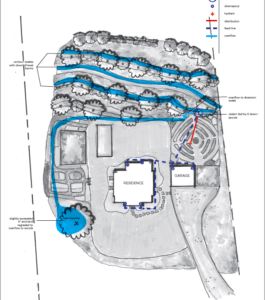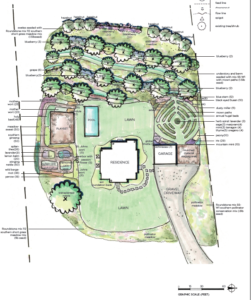We recently planned and installed a home-scale food forest for a client looking to transform their newly graded backyard (after constructing their home) into a diverse planting of fruit trees and berries, with a mixed-species meadow understory for pollinator support and soil repair.

Before: The hillside is a gentle 3:1 slope, full sun

Immediately after installation: December 2020
Water
All the roof water routes to an above-ground cistern for irrigation and the cistern’s overflow directs through contoured swales along a hillside. This captures the overland flow and allows it to sink into the soil near the trees’ root zones, minimizing the need for irrigation. One challenge in installing swales in the winter is that when working with heavy clay soils, they tend to hold lots of water because it is our wet season.
With the clay and the standing water, it can be challenging to get seed to sprout in the swales in the winter, especially because it ultimately takes the plants’ root structure to decompact the soils enough to allow the water to infiltrate. We have found one workaround to fill the swales with an engineered soil mix while still allowing a ponding depth between the soil level and the top of the berm to give a growing medium for the seeds to germinate quickly.

Soil
Post-construction compacted clay soil presented a big challenge on this site. Introducing water and allowing it to infiltrate helps encourage more soil microbes and organic matter, with the addition of cover-cropping seeds to add nutrients. Installing this in the winter, we seeded the entire understory with Austrian winter pea (a nitrogen fixer), daikon radish (to decompact the soil), winter rye (for green manure/thatch after mowing the cover crop, adding valuable organic matter), and hairy vetch (a nitrogen fixer).
We then overseeded a custom meadow mix of entirely native perennials and grasses to repair post-construction soils for the long run and encourage pollinators. We seeded the meadow mix into the winter cover crop, but will start sprouting up later in the season.
Plants
The orchard includes species such as apple, fig, pomegranate, Asian pear, Fuyu persimmon, and more. We used a cross-pollination cluster pattern for designing this orchard. This pattern is found in nature, as identified in Dave Jacke’s book, Edible Forest Gardens Vol.1. It is based on utilizing fruit trees from many different plant families to encourage resilience. We planted the fruit trees close enough together to cross-pollinate but far enough apart that they don’t share pests and diseases.
Instead, trees in the same plant family are separated by a different plant family. For example, many of our fruits we eat are in the Rosaceae (the Rose) family, including apples, cherries, peaches, plums, raspberries, strawberries, pears, and more. Rather than placing these species near one another, we add intermittent plantings from other families, such as mulberry, chestnut, pomegranate, fig, persimmon, and others. We have had incredible results with this pattern, minimizing the spread of blights that affect rose family fruits, such as fire blight and cedar rust.
